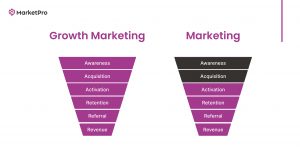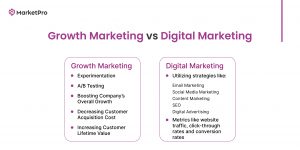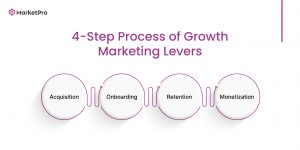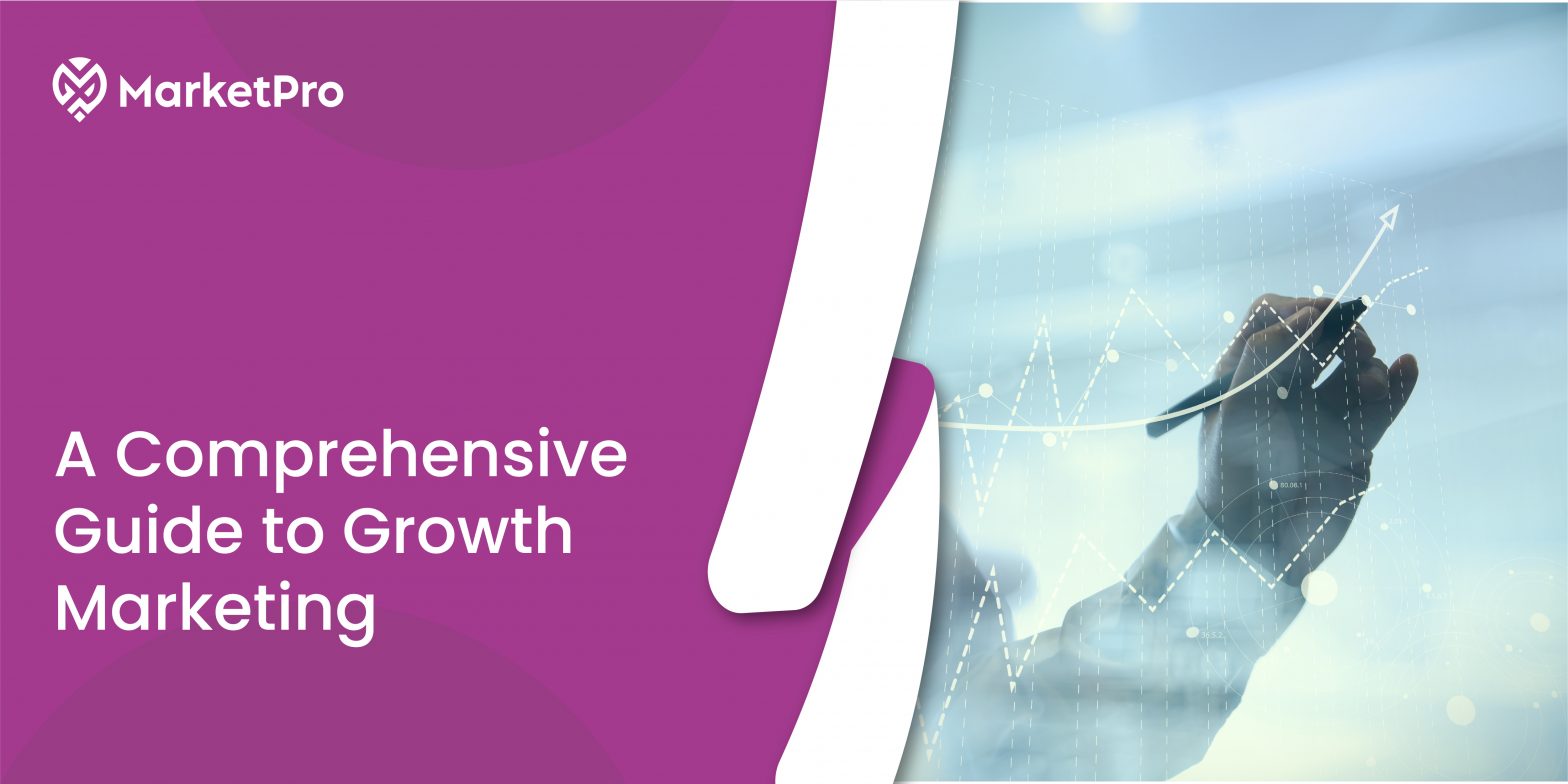In today’s dynamic landscape, consumer habits and preferences shift rapidly. Competitors’ marketing strategies constantly evolve, compelling businesses to stay vigilant. This constant change necessitates firms to continuously refine their tactics and mindsets to stay aligned with evolving market demands.
At present, there is no magic wand that guarantees sustainable market growth. Companies must constantly evolve and test different strategic scenarios to achieve desired outcomes.
In order to thrive, marketers must embrace change, tap into customer insights, and leverage real-time analysis to stay ahead of market trends. This helps them better anticipate and respond to shifting consumer needs and preferences, thus securing a more enduring presence and resounding market growth.
Dive deeper to explore the major terminologies of growth marketing and how it can accelerate any business’s growth with consumer-centric tactics.
What is Growth Marketing?
Growth Marketing is a full-funnel marketing strategy that addresses all stages of the buyer journey instead of traditional marketing, focusing on brand awareness and top-of-the-funnel stages. Growth marketing aims to complement a complete cycle of the user’s customer journey, from arousing initial awareness to driving conversions and beyond. Doing all of this by executing different types of testing, experimentation, and marketing efforts to increase Customer Lifetime Value (CLV).

Growth Marketing Vs. Digital Marketing
Digital marketing is an umbrella term that essentially means any digital marketing tactic or strategy that can be utilized on any digital channel or platform. Such as Email marketing, social media management, paid search advertising, organic Search Engine Optimization (SEO), and other marketing terms.

Growth marketing focuses on a new mindset, prioritizing growth over creating disparate tactics. It places growth at the core of its efforts, utilizing testing, experimentation, and various strategies to drive business results. This approach aims to increase sales and positively impact the bottom-line results through continuous improvement and innovation.
Suggested Read: Digital Marketing Statistics: The Ultimate Checklist for Staying Ahead of the Curve
Growth Marketing vs Growth Hacking
Growth marketing and hacking operate on data-driven marketing tactics, as these skill sets deal with numbers, percentages, and data analytics tools. Also, both are goal-oriented, whether to increase sales, the number of customers, or growing their market share, all adding up to achieve specific goals. While there are some similarities, their differences must be duly noted.
Some of the significant differences between growth marketing and growth hacking are:
Brand Management:
Growth hacking works on an approach that acquires as many customers as possible, neglecting the importance of making a brand. Growth marketing usually takes a slow process, first focusing on creating meaningful connections with the target audience and building a brand.
Product-Market Fit:
A growth marketing strategy is usually adopted by businesses that already have an established audience and have given them results. Growth hacking is generally adopted by companies that haven’t achieved a product market fit and hire growth marketers to speed up their hacking marketing campaigns to increase their customer base.
Momentum:
The significant difference between growth marketing and hacking is the speed and pace of earning results. Growth marketing involves techniques and marketing efforts to create a brand, which usually doesn’t occur overnight. At the same time, growth hacking produces fast results and aims to generate results relatively quickly.
Crucial Levers of Growth Marketing
A well-defined sales funnel can increase the deal win rate by 16%. And as we know, growth marketing covers all the funnel stages of the consumer life cycle. In contrast, traditional marketing more likely focuses on top-of-the-funnel stages, only focusing on the awareness and acquisition stages.

Now let’s dig deep into the levers that growth marketers look after:
1. Acquisition
Growth marketing operates by understanding the target customer profile first and experimenting with different scenarios to understand which marketing channel will suitably work best for them.
Some of the channels can be:
- Referral Design Marketing: Incentivizing customers to refer their brands to other customers, more likely fall under word-of-mouth marketing
- Content Loops: Create step-by-step marketing strategies to develop, engage, and promote content with the target audience. Generally, it comes under using content marketing services.
- Paid Ads: This involves digital advertising based on desired customer profiles on search engines and social media platforms. Generally, Google ad services and social media management come in handy.
Acquisition contains lots of work, from hitting a product market fit to scaling the product to the mature phase of its growth cycle. It also includes tasks like user research, copywriting, and creating user-friendly landing pages.
2. Onboarding
In growth marketing, the onboarding stage is not the usual greetings or welcome email tour for the product. Many marketers’ research goes into the onboarding stage, from understanding their online behaviors to measuring their points and needs.
Therefore, growth marketers create personalized onboarding content that guides users to a series of relatable moments and only shows the features of products or services that resonate the most with them. Rather, they give an utterly baseless overview of what their product does. They aim to market content that shows how it helps them or adds value rather than describing irrelevant elements.
3. Retention
One of the differentiators of growth marketing is its extensive framework, which keeps adapting to the marketing mindset and approach that manages the bottom-end stages of the funnel, too. After capturing the target audience growth, marketers work to retain and re-engage their users with different marketing tactics and experimental strategies to increase their customer lifetime value.
Growth marketing firms create strategies to utilize customer insights and create personalized customer experiences. Businesses conduct loyalty programs, promotional campaigns, and other ways to incentivize their customers to strengthen their loyalty and encourage them to develop long-term relationships.
4. Monetization
79% of acquired leads never reach the conversion stage and fail to turn into sales.
Finally, monetization is one of the essential and under-utilized growth marketing strategies. It’s a strategy where marketers decide who to charge first from their customer segments and how to charge them based on their customers’ buying power and position. It includes pricing questions like:
- Whether to go for a subscription model?
- Or should we stick to the transactional model?
- Or should we introduce tiered pricing features?
- So on and so forth.
Monetizing isn’t limited to mere price changes, but it’s carefully positioned relative to understanding their customer value and to which extent the product can help.
Growth Marketing Campaigns
Growth marketing campaigns focus on attracting new users, developing strategies to ramp up conversion results, keeping existing customers interested and engaged, and finally, thriving for better business growth.
Some of the essential growth marketing campaigns are:
1. Acquisition-Focused Campaigns
This campaign aims to generate top-of-the-funnel results where marketers create techniques and marketing efforts to get new people and increase their customer’s growth.
This involves content marketing services, which include creating valuable content like blogs, whitepapers, etc, to attract target audiences and increase their lead-generation cycle. SEO also helps rank the website’s content on top of search engine results pages (SERPs). Others include social media marketing and paid advertising efforts to ramp up the growth of their leads and conversions.
2. Engagement Focused Campaigns
In growth marketing, it’s believed it’s easier and more profitable to retain a customer than to acquire a new one. Growth marketers create campaigns that glue their existing customers with their cause. Some of them are:
- Email marketing: Building a segmented list and sending constant emails to existing customers to promote new features and solidify their relations.
- Referral Programs: Rewarding customers to refer their products and services to their relatives or friends.
- Community Building: Creating online communities through online forums and social media groups to keep the relationships thriving and engaged.
Ignite Your Growth Marketing Journey With Market Pro
Growth marketing offers a strategic approach to drive business success in today’s dynamic market. By focusing on the entire customer journey, from acquisition to retention, this strategy leverages data-driven tactics and continuous testing to adapt to changing consumer behaviors while boosting sales and fostering long-term customer loyalty.
Turn website visitors into loyal customers with Market Pro proven Growth Marketing solutions.

